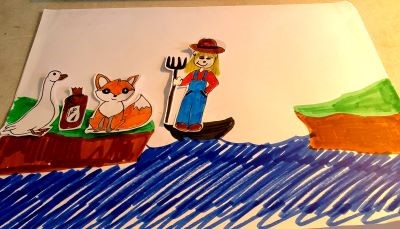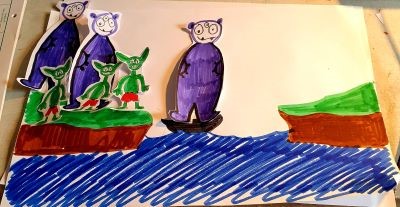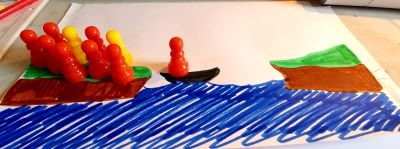| Maths at Home | 1. Problem Solving Introduction | 2. Developing Problem Solving Skills | 3. Encouraging Reflective Thinking | 4. Problem Solving Session | Home |
|---|
4. Problem Solving Session
River Crossing Puzzles are a fun and challenging family of puzzles that are perfect to use for developing problem solving skills
BACKGROUND
Below we have three versions of the classic “River Crossing Problem”. There are many puzzles that fall into this category. Several different items need to be ferried across a river in the shortest number of steps subject to criteria (such as not leaving different items together). Other versions use another setting such as a bridge or tunnel.
These puzzles offer a great opportunity to discuss problem solving strategies:
- Trial and error
- Work backwards
- Find intermediate points, work step by step
- Eliminate what is impossible
- Work with simplifications
- Look for patterns, symmetry
- Make a list or prepare a table of data
- Draw a picture
- Make a physical model
Students may be given advice on how to attempt these puzzles. Encourage lateral thinking – if students think outside the box and suggest that any of the characters in the puzzles could swim across or build another boat etc, then instead of shutting them down, celebrate their lateral thinking by saying “that’s a great suggestion but in this puzzle this is the criteria that must be met…” after all if you were stranded on the bank of a river this is the type of out of the box thinking that you would welcome.
These puzzles will develop the following problem-solving skills:
- logic & reasoning
- basic number skills
- seeking & seeing patterns
- generalisation
- equivalent algebraic expressions
- symbolic representation
- substituting into equations
- solving equations
- graphing ordered pairs
Did you know that these river crossing puzzles are found in Propositiones ad acuendos juvenes (Problems to Sharpen the Young) by Alcuin of York dating from around 800CE
Farmer, Fox, Goose and Cabbage

This is a famous and tricky puzzle. It can be difficult to figure out, but if you create the puzzle with items that you can move, the puzzle may become easier. You can use toys for the farmer, fox, goose, and grain. Otherwise you can draw pictures of each and cut them out.
A farmer must transport a fox, a goose, and some grain across a river. She has a boat which can only carry herself and one other thing. If the farmer is not present, the fox will eat the goose. If the goose and the grain are left together alone, the goose will eat the grain.
How can the farmer transport everything across the river?
When you have done that, answer these questions:
- How many trips will it take?
- What happens if we change the number of items to be transported?
A farmer must transport a fox, a dog, a goose, and some grain across a river. She/he has a boat which can carry himself and one other thing. If the farmer is not present, the fox cannot be left with either the dog or the goose, or both. If needs be, the goose can be left with the grain provided the dog is present because the dog will guard the grain and will not eat the goose.
River Crossing: Six Creatures

A maximum of two creatures are allowed in the boat for each crossing. The goblins must never be outnumbered by the monsters on the banks of the river. The boat will not move if there is no creature in it.
When you have done that, answer these questions?
- How many trips did it take?
- What is the fewest number of trips it could take?
Students can try different ideas: put the items in the boat and bring them across the river in turn. If at any stage, the monsters outnumber the goblins, then just start again. It is ok to try different moves at random but if you are not making progress, you need to reflect on what you are doing that is not working. Make sure to try a different way the next time.
River Crossing: Adults and Children

8 adults and 2 children need to cross the river. Everybody can row the small boat, but it can only carry 1 adult or 1 child or 2 children at a time.
How many crossings will it take to get everyone to the other side of the river?
When you have done that, answer these questions?
- How many trips did it take?
- What is the fewest number of trips it could take?
Students can try different ideas: put the items in the boat and bring them across the river in turn. If at any stage, the monsters outnumber the goblins, then just start again. It is ok to try different moves at random but if you are not making progress, you need to reflect on what you are doing that is not working. Make sure to try a different way the next time.
- What are the choices for the first move? Explore the steps that follow.
- What if there were 100 adults and 2 children?
- What if there were n adults and 2 children?
